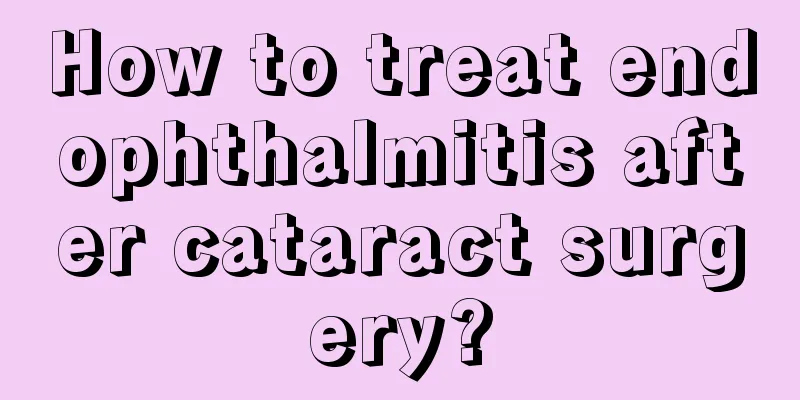How to treat endophthalmitis after cataract surgery?

|
Endophthalmitis after cataract surgery is a relatively common postoperative eye infection. Endophthalmitis is very detrimental to postoperative recovery and can also cause some harm to the eyes, easily leading to eye infection or bacterial growth. There are many ways to treat endophthalmitis, which can be controlled through intravenous injection of drugs. Etiology and pathogenesis 1. Exogenous endophthalmitis: It is often caused by pathogens directly entering the eye due to penetrating injuries to the eye, intraocular surgery, or corneal ulcer perforation. Penetrating injuries to the eyeball, such as small penetrating wounds (injection needle punctures, wire punctures, etc.), plant punctures (reeds, bamboo sticks, etc.) or foreign bodies retained in the eye are most likely to cause endophthalmitis; bleb infections are more common after intraocular surgeries such as cataract surgery and glaucoma surgery. Common pathogens include Staphylococcus aureus, Streptococcus, Pseudomonas aeruginosa and Bacillus cereus. In addition, Staphylococcus epidermidis and Propionibacterium acnes are often the pathogens of endophthalmitis after cataract surgery. Fungal infections often occur in vegetative eye penetration injuries. 2. Endogenous endophthalmitis: refers to bacteria or fungi that spread into the eye through the blood circulation, also known as metastatic endophthalmitis. It is common in patients with immunodeficiency, use of immunosuppressants, long-term use of antibiotics, diabetes, chronic renal failure, liver disease, oral infection, postoperative tumor, endocarditis, etc. Common pathogens include Staphylococcus, Streptococcus, Haemophilus influenzae, etc. The common pathogenic fungus is Candida albicans. Drug treatment 1) Systemic medication: usually administered intravenously. Generally, broad-spectrum antibiotics are used that can cross the blood-retina and blood-aqueous humor barriers. However, due to the existence of the above barriers, it is difficult for antibiotics to reach effective concentrations in the eye. In view of the above reasons, systemic medication can only be used as an adjunctive treatment for endophthalmitis, mainly to prevent and control the extraocular spread of inflammation. 2) Eye drops: Although many antibiotic eye drops can enter the anterior chamber, it is difficult for them to penetrate deeply into the vitreous body, so they have poor efficacy in treating endophthalmitis. Infections in corneal scleral wounds can be treated with frequent application of antibiotic drops. Since this route of administration results in a certain drug concentration in the anterior chamber, it plays a certain role in the prevention and treatment of endophthalmitis caused by anterior segment penetrating injuries. At the same time, using glucocorticoids and atropine eye drops can reduce inflammation of the pigment membrane and keep the pupil dilated to prevent adhesion, which facilitates the next step of observation and treatment of the injured eye. 3) Subconjunctival and juxtabulbar injection: These two injection methods are commonly used in clinical practice, but due to the influence of the blood-aqueous humor barrier, the drug concentration in the vitreous is very low and cannot achieve the purpose of treating endophthalmitis. In order to maintain the effective concentration of antibiotics injected into the vitreous, it is more appropriate to administer the drug by this route for 5 to 7 days. 4) Intravitreal injection: Intravitreal injection of antibiotics can enable intraocular antibiotics to reach effective therapeutic concentrations. The volume of intravitreal injection is generally 0.1 ml. Generally, combination therapy is required (two antibiotics combined, rarely triple therapy, with or without dexamethasone). Depending on the patient's clinical response to treatment, the retention time of antibiotics in the eye, and the results of aqueous humor, vitreous smear, and bacterial culture, repeated injections may be considered 2 days after the first injection. Considering the toxic effects of antibiotics on the retina, the second injection is not routinely used. Antibiotics injected into the vitreous cavity can easily act on the retina and produce toxic reactions to the retina. If the patient has undergone vitrectomy, the dose of intravitreal antibiotics should be reduced by 50%. After 24 hours of anti-infection treatment, if the patient has a significant clinical response, systemic glucocorticoids may be considered to reduce vitreous inflammatory response and further organization. |
<<: How to wash chili oil off white clothes?
>>: The difference between borscht and beetroot soup
Recommend
What are the early symptoms of liver cancer?
What are the early symptoms of liver cancer? I be...
Surgical treatment of colorectal cancer
Surgical removal of the lesion in patients with c...
Problems that should be noted in laryngoscopy in the diagnosis of laryngeal cancer
Issues that should be noted in indirect laryngosc...
What are the effects of Shenrongshen Capsule?
Ginseng and Deer Antler Kidney Capsule is a medic...
Endometrial cancer dietary taboos
What are the dietary taboos for endometrial cance...
Is advanced bladder cancer contagious?
Nowadays, people's living standards have impr...
What to do if hallux valgus hurts
Many children have ugly feet since childhood. Som...
Will pregnant women gain weight if they eat sweet potatoes?
Sweet potatoes have many benefits to the human bo...
Is it better for boys to learn hip-hop or Taekwondo
For many parents, they hope that their children c...
What should I eat for dry eyes recently
With the increasing pressure in our lives, many p...
What causes the scalp to become hot and itchy?
When there is a lot of dandruff, our scalp will b...
Nose bleeding in the morning
Many people feel their nose bleeding every mornin...
How to make a bubble bath
Bubble bath is a very popular bathing method in d...
What is the cure rate for mid- to late-stage testicular cancer?
The cure rate of mid-to-late stage testicular can...
What shoes should pregnant women wear in winter
Many pregnant women who become pregnant in the su...









